UPSC Prelims Previous Year Questions 2022: Geography | Geography for UPSC CSE PDF Download
Q1: Consider the following statements:
- High clouds primarily reflect solar radiation and cool the surface of the Earth.
- Low clouds have a high absorption of infrared radiation emanating from the Earth's surface and thus cause warming effect.
Which of the statements given above is/are correct?
(a) 1 only
(b) 2 only
(c) Both 1 and 2
(d) Neither 1 nor 2
 View Answer
View Answer 
Ans: (d)
The study of clouds, where they occur, and their characteristics, play a key role in the understanding of climate change. Low, thick clouds primarily reflect solar radiation and cool the surface of the Earth. High, thin clouds primarily transmit incoming solar radiation; at the same time, they trap some of the outgoing infrared radiation emitted by the Earth and radiate it back downward, thereby warming the surface of the Earth.
Hence, both statements are not correct.
Q2: Consider the following States:
- Andhra Pradesh
- Kerala
- Himachal Pradesh
- Tripura
How many of the above are generally known as tea-producing States?
(a) Only one State
(b) Only two States
(c) Only three States
(d) All four States
 View Answer
View Answer 
Ans: (d)
Tea is processed within the tea garden to restore its freshness. Major tea producing states are Assam, hills of Darjeeling and Jalpaiguri districts, West Bengal, Tamil Nadu and Kerala. Apart from these, Himachal Pradesh, Uttarakhand, Meghalaya, Andhra Pradesh and Tripura are also tea-producing states in the country.
Q3: Consider the following pairs:
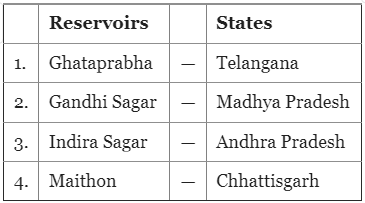
How many pairs given above are not correctly matched?
(a) Only one pair
(b) Only two pairs
(c) Only three pairs
(d) All four pairs
 View Answer
View Answer 
Ans: (c)
- Ghataprabha Reservoir — Telangana: Ghataprabha Reservoir is actually in Karnataka, not Telangana. This pair is incorrectly matched.
- Gandhi Sagar — Madhya Pradesh: Gandhi Sagar Reservoir is indeed located in Madhya Pradesh. This pair is correctly matched.
- Indira Sagar — Andhra Pradesh: Indira Sagar is in Madhya Pradesh, not Andhra Pradesh. This pair is incorrectly matched.
- Maithon — Chhattisgarh: Maithon Reservoir is in Jharkhand, not Chhattisgarh. This pair is incorrectly matched.
Hence, Option (c) is correct.
Q4: Which one of the following lakes of West Africa has become dry and turned into a desert?
(a) Lake Victoria
(b) Lake Faguibine
(c) Lake Oguta
(d) Lake Volta
 View Answer
View Answer 
Ans: (b)
According to the United Nations Climate Change Conference-COP 26, Lake Faguibine in West Africa has dried up and turned into a desert. Hence option (b) is correct.
Q5: Gandikota canyon of South India was created by which one of the following rivers?
(a) Cauvery
(b) Manjira
(c) Pennar
(d) Tungabhadra
 View Answer
View Answer 
Ans: (c)
Gandikota is a Twi village in Cuddapah district of Andhra Pradesh surrounded by the Pennar River on the right, the village is popular for the spectacular valleys formed by the river running through the Erramala hills. The narrow valleys and steep rocky walls with streams running between them look very beautiful. Hence option (c) is correct.
Q6: Consider the following pairs:
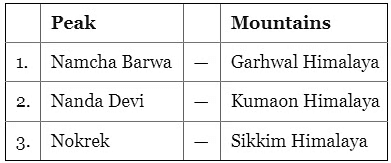
Which of the pairs given above is/are correctly matched?
(a) 1 and 2
(b) 2 only
(c) 1 and 3
(d) 3 only
 View Answer
View Answer 
Ans: (b)
Nanda Devi peaks are a part of Kumaon Himalaya.
- The part of Himalaya situated between Sutlej and Kali rivers is known as Kumaon Himalaya.
- The Greater Himalayas extend from Nanga Parbat in the west to Namcha Barwa Peak in the east.
- The Namcha Barwa mountain range comes under Tibet.
Hence option (b) is correct.
Q7: The term "Levant" often heard in the news roughly corresponds to which of the following regions?
(a) Region along the eastern Mediterranean shores
(b) Region along North African shores stretching from Egypt to Morocco
(c) Region along Persian Gulf and Horn of Africa
(d) The entire coastal areas of Mediterranean Sea
 View Answer
View Answer 
Ans: (a)
The Levant is the eastern shoreland of the Mediterranean, a stretch of land approximately 800 km long and approximately 150 km wide. It is wedged in between the Mediterranean Sea in the west and the Arabo-Syrian Desert in the east, stretching from the mouth of the River Orontes in the north to the Isthmus of Suez in the south. Hence option (a) is correct.
Q8: Consider the following countries:
- Azerbaijan
- Kyrgyzstan
- Tajikistan
- Turkmenistan
- Uzbekistan
Which of the above have borders with Afghanistan?
(a) 1, 2 and 5 only
(b) 1, 2, 3 and 4 only
(c) 3, 4 and 5 only
(d) 1, 2, 3, 4 and 5
 View Answer
View Answer 
Ans: (c)
- Afghanistan originally known as Ariana or Bactra and then as Khorasan (the land of the rising sun) is bounded by Iran and Turkmenistan to its west, Uzbekistan, Tajikistan and Kyrgyzstan to its north, Pakistan to its east and south, while the northeast portion of the Wakhan province of Afghanistan by China.
- Afghanistan has borders with the following countries: China, Iran, Pakistan, Tajikistan, Turkmenistan and Uzbekistan.
Hence option (c) is correct.
Q9: With reference to India, consider the following statements?
- Monazite is a source of rare earths.
- Monazite contains thorium.
- Monazite occurs naturally in the entire Indian coastal sands in India.
- In India, Government bodies only can process or export monazite.
Which of the statements given above are correct?
(a) 1, 2 and 3 only
(b) 1, 2 and 4 only
(c) 3 and 4 only
(d) 1, 2, 3 and 4
 View Answer
View Answer 
Ans: (b)
Monazite ore is found in India, Madagascar and in South-Africa. Monazite is an important ore of rare earths elements thorium, lanthanum, and cerium. The state-wise sources of monazite:
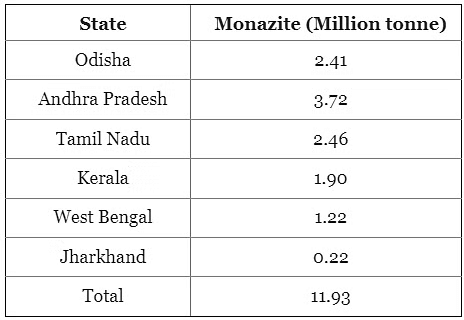
- It is not found all along the Indian coast.
- Private companies were not allowed to mine beach sand minerals until 1993. After liberalisation, private companies were initially allowed to mine garnet and sillimanite and permissions for other minerals followed.
- An earlier amendment in 2016 barred private companies from mining beach sand that had monazite concentration of more than 0.75%.
- Private firms are restricted from processing or exporting monazite. It remains a government monopoly, extracted under the purview of the Department of Atomic Energy.
Hence, option (b) is correct.
Q10: In the northern hemisphere, the longest day of the year normally occurs in the:
(a) First half of the month of June
(b) Second half of the month of June
(c) First half of the month of July
(d) Second half of the month of July
 View Answer
View Answer 
Ans: (b)
In the northern hemisphere ‘Second half of the month june (21st june)’ is the longest day of the year. Hence option (b) is correct.
Q11: Consider the following pairs:
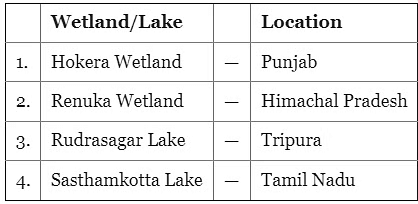
How many pairs given above are correctly matched?
(a) Only one pair
(b) Only two pairs
(c) Only three pairs
(d) All four pairs
 View Answer
View Answer 
Ans: (b)
- Hokera Wetland — Punjab: This is incorrect. Hokera Wetland is actually located in Jammu and Kashmir.
- Renuka Wetland — Himachal Pradesh: This is correct. Renuka Wetland is indeed located in Himachal Pradesh.
- Rudrasagar Lake — Tripura: This is correct. Rudrasagar Lake is located in Tripura.
- Sasthamkotta Lake — Tamil Nadu: This is incorrect. Sasthamkotta Lake is located in Kerala, not Tamil Nadu.
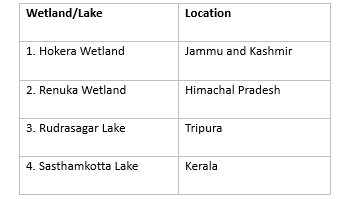
Hence, option (b) is correct.
|
263 videos|874 docs|232 tests
|
FAQs on UPSC Prelims Previous Year Questions 2022: Geography - Geography for UPSC CSE
| 1. What are the key geographical features of India that are important for the UPSC Prelims? |  |
| 2. How does the monsoon season affect the geography and agriculture of India? |  |
| 3. What role do rivers play in the geography of India? |  |
| 4. What are the significant climatic zones in India, and how do they influence the environment? |  |
| 5. How do human activities impact the geographical environment of India? |  |

















